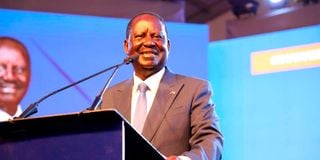Premium
A vanishing goatee and Raila’s endless political contortions

Azimio coalition flag bearer Raila Odinga.
They are saying that Raila Odinga sounds incoherent, looks exhausted, is prone to horrifying messaging howlers and seems confused and detached.
In the beginning, some said it was Covid-19. Others say he was sulking as part of non-verbal bargaining with Uhuru Kenyatta.
Yet still, others suggested that Odinga was not interested in standing for election this time round.
But here we are. Odinga is contesting the presidential election for the fifth time, placing him in his own league as far as political ambition and audacity of hope go. He has vied against three presidents in a row, who have proceeded to serve their full terms.
But what account gives us the best explanation of Odinga’s bizarre displays?
Why is he muddled, lugubrious and dissipated at the grand stage he is well experienced in, in the heat of the contest of his life? Why does he seem to be choking on the moment?
In stark, elementary terms, Odinga is exposed. He has sustained an astonishingly long run in high-level politics without any message at all and is now confronted with an election that explicitly demands a clear message. Odinga’s long run has been anything but plain sailing.
He has hunted with the hounds and run with the hares, consistently confounding friend and foe, who understandably could not tell whither, whence and wherefore he goeth or cometh.
Fidel Castrol
Odinga’s foremost idol and hero is Fidel Castro.
The son of a stupendously rich Vice-President, Odinga began his schooling in communist East Germany two years after the dashing bearded revolutionary seized power in a coup, made Cuba a communist one party state and himself prime minister, then president.
Odinga seared his way into national consciousness as a bearded zealot accused of trying to overthrow Daniel Moi in the infamous 1982 coup.
For two decades, Odinga assiduously maintained this revolutionary profile, polarising national politics as a much adored icon of young anti-establishment youths and a violent anarchist profoundly dreaded by regime elites.
Odinga lost his first presidential election in 1997, and promptly rejected the results.
Shortly thereafter, Odinga was in political talking stage with Moi, which was consummated in ‘cooperation’, and Odinga’s appointment as minister for Energy. It culminated in a merger in 2002, whereby Odinga’s National Development Party was dissolved and he became Kanu secretary-general.
At the same time, Odinga underwent a visible sartorial metamorphosis.
Marxist suits gave way to western formal suits, and his Castro beard was trimmed into a severely tamed bourgeoisie goatee.
When Moi preferred Kenyatta as his successor, Odinga left Kanu, took a quick shower and returned to the market, where he found Kibaki.
Thus began the National Rainbow Coalition (Narc), and the only election in 25 years that Odinga did not contest.
After falling out mid-term with Kibaki, Odinga was sacked as minister for Roads, Public Works and Housing, and formed ODM, under whose standard he duked it out with Kibaki in the testy 2007 skirmish.
Odinga once again rejected the results and negotiated his way into Kibaki’s government as prime minister with power over roughly half of the executive.
By this time, Odinga’s goatee was firmly on its last legs.
In 2013, Odinga finally faced Kenyatta in direct battle, and the two heaped each other with the cruelest epithets as they angrily mobilised regional constituencies.
Kenyatta prevailed, Odinga rejected the results, but this time round, petitioned the Supreme Court.
Kenyatta was vindicated. In 2017, Kenyatta and Odinga had a last hurrah with similar results, eventually.
In 2018, Odinga joined Kenyatta’s government, and was rewarded with appointment as the African Union High Representative for Infrastructure Development, priority in presidential succession consideration, administrative facilitation and campaign support.
To achieve the endless succession of contradictory political manoeuvres that Odinga has executed in four decades requires a contortionist’s flexibility.
The most flexible mode of existence is, of course, formlessness. That is how Odinga has managed his political message. By carefully staging his political performance and sedulously curating his body language, Odinga only implies messages without explicitly committing to them. This messaging by suggestion affords his audiences a receptive space to project and animate their political delusions. It is why his most fanatical adherents also describe him as ‘Agwambo’, the enigma.
Kitendawili
Odinga’s legendary repertory in political rallies opens with a riddle; kitendawili.
There follows a story, which profiles others who will shortly be castigated, scandalised and reviled.
Afterwards, the repertoire segues into football commentary in which Odinga’s adversaries bungle and fail as Odinga dazzles and wins. And that is the end of the rally.
Odinga’s formless messaging is highly strategic, and renders him appropriately malleable, thus able to fight his rivals viciously one minute, and lavish them with adoring platitudes the next. His goal is power. His agenda is unknown and unknowable because it doesn’t exist. That is why he recently said that hydrogen exists here “in large numbers”. And that mitumba are clothes that are worn by people who are dead. He has nothing to say, and now we know it.
Mr Ng’eno is an advocate of the High Court and a supporter of William Ruto’s presidential candidacy. @EricNgeno





